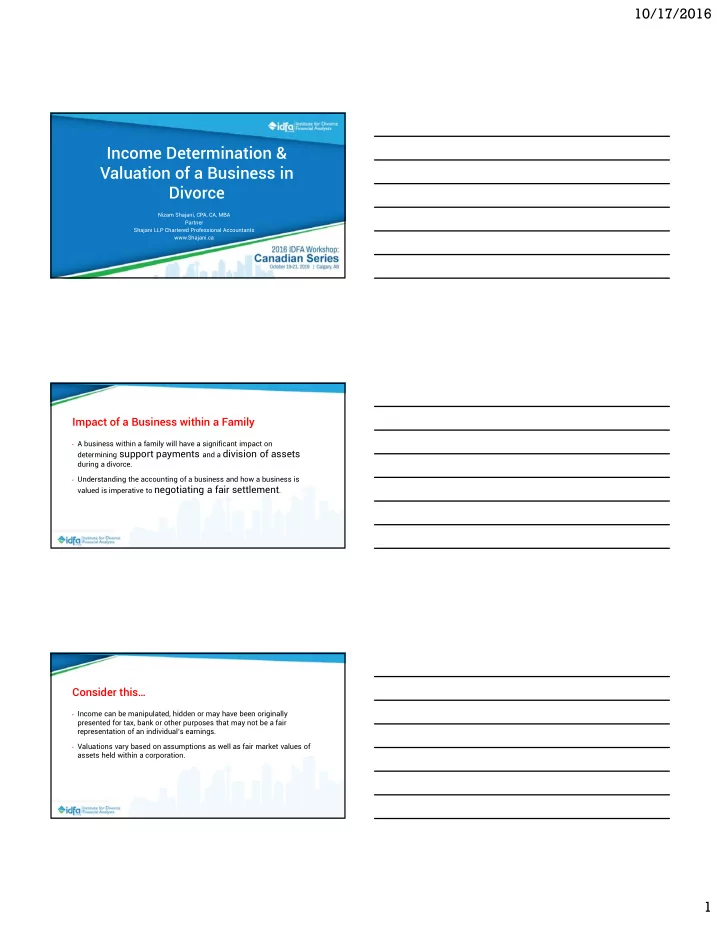

10/17/2016 Income Determination & Valuation of a Business in Divorce Nizam Shajani, CPA, CA, MBA Partner Shajani LLP Chartered Professional Accountants www.Shajani.ca Impact of a Business within a Family • A business within a family will have a significant impact on determining support payments and a division of assets during a divorce. • Understanding the accounting of a business and how a business is valued is imperative to negotiating a fair settlement . Consider this… • Income can be manipulated, hidden or may have been originally presented for tax, bank or other purposes that may not be a fair representation of an individual’s earnings. • Valuations vary based on assumptions as well as fair market values of assets held within a corporation. 1
10/17/2016 Notice to Reader • One the basis of information provided by management, we have compiled the balance sheet of the corporation as at December 31, 2016 and the statement of income and retained earnings for the year then ended. • We have not performed an audit or a review engagement in respect of these financial statements and, accordingly, we express no assurance thereon . • Readers are cautioned that these statements may not be appropriate for their purposes. Income Determination from a Small Business • Line 150 on the Personal Tax Return may be manipulated based on • Tax Planning • Accounting Policies • Fraud Valuation • The value of a business is subject to changes in fair market values and a number of assumptions • Net Asset Approach • Multiple of Income • Earnings Based Approach 2
10/17/2016 Personal Tax Return - Line 150 • Total Income • Employment • Dividend • Interest • Rental • OAS/CPP • Pensions • Support Payments Tax Planning Divorce STATEMENT OF INCOME Salary Dividend Planning Revenue 200,000 200,000 200,000 Expenses 100,000 100,000 100,000 Salary 100,000 - - Income before tax - 100,000 100,000 Corporate tax - 13,500 13,500 Income available to distribute - 86,500 86,500 Dividend - 86,500 - Retained Earnings - - 86,500 Tax Planning • Revenues • Cash based vs. Accrual • Expenses • Non-taxable benefits (health, insurance premiums) • Vehicle millage • Home office • Phone • Balances sheet loans at prescribed rate 3
10/17/2016 Accounting Policies • Notice to Reader Statements may not follow GAAP • Accounting policies are not the same as tax policies Accounting Policies • Revenue Recognition • Earned vs. Deferred Revenues • Timing • Expenses • Non-taxable benefits (health spending, life insurance premiums, non-cash gifts) • Non-cash expenditures (amortization, bad debt) • Timing Fraud • Revenues • Deposits made to another account • Deposits made as Shareholder Loans • Cash not deposited to corporate accounts • Barter 4
10/17/2016 Fraud • Expenses • Over claiming management fees to third parties • Dividends paid to non-shareholders • Fictional expenses Fraud Detection • Variance Analysis two years prior to separation • Measure variances with economic factors and other similar businesses within the industry • Agree expenses with invoices and payments • Trace employment expenses to T4 filings • Trace management remuneration to personal tax returns Valuation • Estimation of the value of a business as a measure in splitting assets in a divorce. 5
10/17/2016 Valuation Approaches • Net Asset Based • Earnings Based • Excess Earnings Based Net Asset Based Approach • Assets less Liabilities • Liquidation value of the company, taking into account the income tax consequences of any asset appraisal increments or write downs • Consider changes in values (FMV) • Marketable Securities • Property Earnings Based Approach • The present value of the future benefits of ownership of the Company. • Inherent Assumptions: • Normalized earnings • Capitalized (discount) rate 6
10/17/2016 Excess Earnings Based Approach • The present value of the future benefits of ownership of the Company. • Inherent Assumptions: • Normalized earnings • Capitalized (discount) rate on tangible assets • Capitalized (discount) rate on intangible assets • Fair Market Value of tangible assets Valuation • Likely looking at a range and can negotiate something in-between • www.Shajani.ca • Finding fulfillment through advanced relationships by delivering trusted professional services that meet your needs and support you in achieving your ambitions. • Shajani LLP can provide you an analysis of your client’s financial statements and personal tax returns to direct questioning as well as valuations for small businesses for a division of assets. 7
Recommend
More recommend